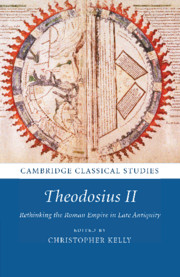
-
Select format
-
- Publisher:
- Cambridge University Press
- Publication date:
- September 2013
- August 2013
- ISBN:
- 9781139839075
- 9781107038585
- 9781108816410
- Dimensions:
- (216 x 138 mm)
- Weight & Pages:
- 0.54kg, 342 Pages
- Dimensions:
- (216 x 140 mm)
- Weight & Pages:
- 0.43kg, 342 Pages
You may already have access via personal or institutional login
Book description
Theodosius II (AD 408–450) was the longest reigning Roman emperor. Ever since Edward Gibbon, he has been dismissed as mediocre and ineffectual. Yet Theodosius ruled an empire which retained its integrity while the West was broken up by barbarian invasions. This book explores Theodosius' challenges and successes. Ten essays by leading scholars of late antiquity provide important new insights into the court at Constantinople, the literary and cultural vitality of the reign, and the presentation of imperial piety and power. Much attention has been directed towards the changes promoted by Constantine at the beginning of the fourth century; much less to their crystallisation under Theodosius II. This volume explores the working out of new conceptions of the Roman Empire - its history, its rulers and its God. A substantial introduction offers a new framework for thinking afresh about the long transition from the classical world to Byzantium.
Reviews
‘The reader of this volume is offered valuable insights into one of the crucial periods in the history of the Christian Church.’
Fergus Millar Source: Journal of Ecclesiastical History
Contents
Metrics
Altmetric attention score
Full text views
Full text views help Loading metrics...
Loading metrics...
* Views captured on Cambridge Core between #date#. This data will be updated every 24 hours.
Usage data cannot currently be displayed.
Accessibility standard: Unknown
Why this information is here
This section outlines the accessibility features of this content - including support for screen readers, full keyboard navigation and high-contrast display options. This may not be relevant for you.
Accessibility Information
Accessibility compliance for the PDF of this book is currently unknown and may be updated in the future.


